Overview
- Brief Narrative
- Petticoat with an eyelet ruffle brought to the United States by Herta Schwarzbart Stoer when she emigrated from Vienna, Austria, in February 1939. The underskirt was created in the early 1900s by her parents, Arthur and Pauline, who ran their own lingerie manufacturing business. Herta lived in Vienna with her parents, and four siblings: Hilda, Fritz, Ella, and Hansi. In August 1914, Arthur was selected to fight in World War I, and three months later, he died of tetanus. As a result, Pauline closed the business, and sent Fritz, Ella, Herta, and Hansi to an orphanage. Hilda and Pauline ran a small children’s clothing business. Herta was transferred to a boarding school for Jewish orphan girls, where she later returned as a teacher. In 1932, Hansi married and moved to Palestine. In early 1936, Herta began dating Leopold (Leo) Stoer. In June 1937, Pauline passed away. On March 13, 1938, Austria was annexed into Germany. Later that month, Herta and Leo married, but continued to live separately in Vienna. Leo immigrated to the US in September 1938, followed by Herta in February 1939. In September, the couple moved to California, where they began running a chicken farm to raise money to help their families immigrate. As World War II progressed, Herta and Leo lost contact with most family members. Herta later learned that her family members had been deported to concentration camps and killed in 1942 or 1943. Only her sister-in-law, Sidi, and nephew, Paul Schwarzbart, survived in hiding. Leo’s entire family had been deported to concentration camps and killed in 1942.
- Date
-
creation:
1901-1914
emigration: 1939 February
- Geography
-
creation:
Vienna (Austria)
en route: United States
- Credit Line
- United States Holocaust Memorial Museum Collection, Gift of Joyce Stoer Cordi
- Contributor
-
Subject:
Herta Stoer
Designer: Arthur Schwarzbart
- Biography
-
Herta Schwarzbart (later Stoer, 1908-2007) was born in Vienna, Austria-Hungary, to Arthur (1875-1914) and Pauline Flesch (1873-1937) Schwarzbart. Arthur was born in Terezín, Austria-Hungary, to Alexander and Rosala Schwarzbart. Arthur had five siblings. Arthur’s mother died in the late 1890s, and his father later married Josephine, who had two sons. Pauline was born in Vienna, to Abraham and Johanna Ernst Flesch. Pauline had an older sister, Hermine or Minna (later Tischler, 1869-1943), and a younger brother, Samuel or Sammy. Pauline’s mother died in 1912, and her father later remarried. He had a son before dying in 1917. In 1895, 20-year-old Arthur was corresponding with Pauline while serving in the Austro-Hungarian army in Moravia. In 1900, Arthur and Pauline married in Vienna. Herta’s aunt Minna married, had two children, and ran a candy store. Herta’s Uncle Sammy was wounded during World War I, and died of complications in the 1930s. After Herta’s oldest sister, Hilda (1901-1942), was born, Arthur, worked briefly in Germany, while Pauline worked from home, sewing for a girdle factory. Herta had three other siblings: Friedrich (Fritz, 1902-1945), Gisela (Ella, 1904-1942), and Hansi (1913-?). Pauline taught Arthur how to sew and he began designing fancy petticoats. He would take orders from wholesalers, and then both he and Pauline would fill the orders at home. Their company grew to employ 125 additional seamstresses. Herta’s family lived very comfortably, with a hired maid and vacations at a resort in the Alps.
World War I began in August 1914, and as a member of the peacetime army, Arthur was called up immediately. In November, Arthur was shot while fighting on the Russian front. He developed a tetanus infection and died. The war prevented Pauline from buying material for the business, and she was forced to close. With inadequate resources at home, 6-year-old Herta, Ella, Hansi, and Fritz were placed in an orphanage in early 1915. The children attended school at the orphanage and Pauline was able to visit them there. Meanwhile, Pauline and Hilda moved into an apartment above a small storefront where they sold candy. As food shortages increased, there was no candy left to sell, so Hilda began to sell children’s clothing in their shop instead. Herta and her siblings attended school at the orphanage. Eventually, Herta began attending a school for Jewish orphan girls. The entire year revolved around Jewish holidays and Herta wrote and directed plays for the other students. After finishing school, 16-year-old Herta attended a secretarial school, where she learned English. After two more years, Herta left the orphanage to work as a governess.
When she was 19, Herta’s school reached out and asked her to return as a teacher. While there, she completed a part-time course of study at a teacher’s college, and became proficient in French. Her brother Fritz married Sara Ryfka Schneider (Sidi, 1908-1969) in 1931, and had a son, Paul, in 1933. Herta’s sister Hansi became a Zionist, met and married Gyuri Loeffler in 1932, and moved to Palestine. In late 1935 or early 1936, Herta’s friend Richard Krochmalnik introduced her to Leopold Stoer (Leo, 1907-2005), an insurance mathematician preparing for his PhD in psychology. Not long after the two began dating, she lost her job at the orphanage because the new director did not like her, and began teaching at another school. She moved in with her mother and sister, Hilda, who still ran a children’s clothing store below their apartment. On June 1, 1937, Herta’s mother, Pauline, passed away.
On March 13, 1938, Austria was annexed into Germany, in what became known as the "Anschluss." The Germans quickly introduced anti-Jewish legislation and confiscated Jewish-owned businesses. Aunt Minna’s candy store was looted, and Hilda was forced to give up her shop, although she still sold clothing from their apartment. The annexation prompted Leo to apply for an immigration visa to the United States. On March 27, Herta married Leopold. Herta’s family members also applied for visas, but their quota numbers were very high. Herta had married Leo after his application was submitted, so she was not included on his visa. Fritz bribed guards to allow him into Belgium, where his wife and son later joined him. Fritz kept in contact with Leopold’s family, who had been smuggled into Belgium as well. In September, Leo’s quota number came up, and he immigrated to the US. He was able to obtain an affidavit for Herta, but she still needed a passport for the visa. To acquire a passport, she had to report to the Rothschild Palace, the processing office for Jewish immigration. She waited in line at the front of the Palace all night, with hope of securing entry the following morning and before being chased away by soldiers. One day, a friend made it near the front and helped Herta get inside to collect her passport. In February 1939, she said goodbye to her sisters, and travelled to Cherbourg, France, before sailing to the US. In April 1939, Herta and Leo moved to San Francisco, California. Initially, Herta worked at a Jewish orphanage, and Leo worked as a consultant at a children’s psychological clinic. In late September 1939, they moved to Petaluma, where she and Leo secured a loan and began running a chicken farm. This seemed the fastest way to make money and prove to the American Consul in Antwerp, Belgium, that they could provide for their family members if they were allowed to immigrate.
Germany invaded Belgium in May 1940, preventing Fritz, his family, and Leopold’s relatives from leaving. Following the invasion, German and Austrian refugees were treated as enemy aliens. On August 1, Herta’s brother Fritz was deported to Saint-Cyprien internment camp in France. Later, he was transferred to Drancy transit camp. Fritz’s wife, Sidi, and son, Paul, hid in the home of a Belgian school teacher’s family, and she pretended to be their maid. In July 1941, all American consulates in German-occupied territory closed, cutting off applicants like Hilda and Ella, who had secured affidavits of support, from the diplomats that could issue visas. In August, Herta and Leo’s first child was born, and they were able to share the news with their families. On May 27, 1942, Hilda and Ella were deported to Maly Trostinec concentration camp in Belorussia (now Belarus), where they were killed on June 1. On August 20, Aunt Minna was deported on transport 37, train Da 504 to Theresienstadt ghetto-labor camp in German-occupied Czechoslovakia, where she was later killed. On August 26, 1942, Fritz was deported on transport 24, train 901-19 to Auschwitz-Birkenau killing center in German-occupied Poland. Fritz was later transported to Buchenwald concentration camp in Germany, and then sent to Gross-Rosen concentration camp on February 10, 1945. Fritz died of sepsis later that month during a forced march to another camp.
Herta and Leo’s second child was born in July 1943. The war ended in May 1945, and the majority of Herta and Leo’s relatives still living in Europe had perished. Fritz’s wife, Sidi, and son, Paul, had survived in hiding, and joined Herta and Leo in California in 1948. In the late 1950s, Leo and Herta sold the chicken business and returned to their pre-war career paths. Herta attended college and studied French and German, which she later taught. Leo returned to school, and interned at a mental hospital before becoming a doctor there.
Physical Details
- Classification
-
Clothing and Dress
- Category
-
Women's clothing
- Object Type
-
Petticoats (underskirts) (aat)
- Genre/Form
- Lingerie.
- Physical Description
- Women’s, knee-length, cream-colored, matelassé cloth A-line underskirt with a drawstring closure at the waist. The plain, lightweight cloth waistband is approximately 2 inches high and is neatly folded along the top to form a two layered band ending at a long, neatly-finished, v-shaped slit on one side. The layers are stitched together to form an inch high channel for the drawstring, now missing, to pass through. The waistband is machine stitched to the gathered top of the skirt’s body, which consists of four panels sewn with vertical French seams. The thick, woven cloth of each panel has a raised, repeating diamond pattern with nine raised inner dots and latticed borders. Sewn along the body’s lower edge is a wide ruffle comprised of a two and a half inch high cloth band, matching the waistband material, with two narrow, horizontal tucked pleats and a one and a half inch high wide eyelet lace ruffle decorated with satin stitched white flowers. The skirt has been taken in on both sides of the slit, just below the waistband. The skirt is unlined and the interior body is pilled and tufted from wear. There are several small, red stains throughout and several repaired holes in the back waistband.
- Dimensions
- overall: Height: 27.500 inches (69.85 cm) | Width: 14.125 inches (35.878 cm)
- Materials
- overall : cloth, thread
Rights & Restrictions
- Conditions on Access
- No restrictions on access
- Conditions on Use
- No restrictions on use
Keywords & Subjects
- Topical Term
- Fashion designers--Austria--Vienna--Biography. Holocaust survivors--United States--Biography. Holocaust, Jewish (1939-1945)--Austria--Vienna--Personal narratives. Austria--Emigration and immigration--History--20th century. United States--Emigration and immigration--History--20th century. Jews--Persecutions--Austria. Clothing and dress--Austria--Vienna. Chickens--Hatcheries.
- Geographic Name
- Vienna (Austria) Belgium. France. Germany. Czech Republic. Poland. United States.
Administrative Notes
- Legal Status
- Permanent Collection
- Provenance
- The underskirt was donated to the United States Holocaust Memorial Museum in 2018 by Joyce Cordi, the daughter of Leopold and Herta Stoer.
- Record last modified:
- 2023-09-15 10:20:48
- This page:
- https://collections.ushmm.org/search/catalog/irn616395
Download & Licensing
In-Person Research
- By Appointment
- Request 21 Days in Advance of Visit
- Plan a Research Visit
- Request to See This Object
Contact Us
Also in Leopold and Herta Stoer family collection
The collection consists of opera glasses, buttons, textiles, petticoats, a Rorschach ink blot test, and a composition book, relating to the experiences of Leopold and Herta Schwartzbart Stoer and their family in Austria before the Holocaust and in Austria, Belgium, Poland, and the United States during the Holocaust.
Date: approximately 1898-1948
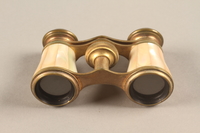
Opera glasses and case owned by a Jewish Austrian refugee
Object
Opera glasses with mother-of-pearl panels brought to the United States by Herta Schwarzbart Stoer when she emigrated from Vienna, Austria, in February 1939. Herta lived in Vienna with her parents, Arthur and Pauline Schwarzbart, and four siblings: Hilda, Fritz, Ella, and Hansi. In August 1914, Arthur was selected to fight in World War I, and three months later, he died of tetanus. As a result, Pauline had to close the lingerie business they ran together before the war. Her daughter, Hilda began making and selling children’s clothing. Pauline’s younger children, Fritz, Ella, Herta, and Hansi, were sent to an orphanage. Herta was transferred to a boarding school for Jewish orphan girls, where she later returned as a teacher. In 1932, Hansi married and moved to Palestine. In early 1936, Herta began dating Leopold (Leo) Stoer. In June 1937, Pauline passed away. On March 13, 1938, Austria was annexed into Germany. Later that month, Herta and Leo married, but continued to live separately in Vienna. Leo immigrated to the US in September 1938, followed by Herta in February 1939. In September, the couple moved to California, where they began running a chicken farm to raise money to help their families immigrate. As World War II progressed, Herta and Leo lost contact with most family members. Herta later learned that her family members had been deported to concentration camps and killed in 1942 or 1943. Only her sister-in-law, Sidi, and nephew, Paul Schwarzbart, survived in hiding. Leo’s entire family had been deported to concentration camps and killed in 1942.
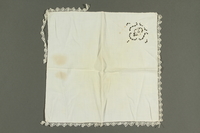
Lace-trimmed Handkerchief with a cutwork floral accent owned by a Jewish Austrian refugee
Object
Lace-trimmed handkerchief brought to the United States by Herta Schwarzbart Stoer when she emigrated from Vienna, Austria, in February 1939. Herta lived in Vienna with her parents, Arthur and Pauline Schwarzbart, and four siblings: Hilda, Fritz, Ella, and Hansi. In August 1914, Arthur was selected to fight in World War I, and three months later, he died of tetanus. As a result, Pauline had to close the lingerie business they ran together before the war. Her daughter, Hilda began making and selling children’s clothing. Pauline’s younger children, Fritz, Ella, Herta, and Hansi, were sent to an orphanage. Herta was transferred to a boarding school for Jewish orphan girls, where she later returned as a teacher. In 1932, Hansi married and moved to Palestine. In early 1936, Herta began dating Leopold (Leo) Stoer. In June 1937, Pauline passed away. On March 13, 1938, Austria was annexed into Germany. Later that month, Herta and Leo married, but continued to live separately in Vienna. Leo immigrated to the US in September 1938, followed by Herta in February 1939. In September, the couple moved to California, where they began running a chicken farm to raise money to help their families immigrate. As World War II progressed, Herta and Leo lost contact with most family members. Herta later learned that her family members had been deported to concentration camps and killed in 1942 or 1943. Only her sister-in-law, Sidi, and nephew, Paul Schwarzbart, survived in hiding. Leo’s entire family had been deported to concentration camps and killed in 1942.
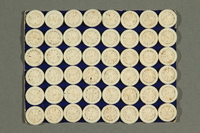
Card with 48 Dorset-style buttons owned by a Jewish Austrian refugee
Object
Unused set of handwoven buttons brought to the United States by Herta Schwarzbart Stoer when she emigrated from Vienna, Austria, in February 1939. The buttons were likely from one of Herta’s family member’s clothing businesses: either lingerie made by her parents, Arthur and Pauline, or children’s clothing made by her sister, Hilda. Herta lived in Vienna with her parents, and four siblings: Hilda, Fritz, Ella, and Hansi. In August 1914, Arthur was selected to fight in World War I, and three months later, he died of tetanus. As a result, Pauline closed the business, Hilda began making children’s clothing, and Fritz, Ella, Herta, and Hansi were sent to an orphanage. Herta was transferred to a boarding school for Jewish orphan girls, where she later returned as a teacher. In 1932, Hansi married and moved to Palestine. In early 1936, Herta began dating Leopold (Leo) Stoer. In June 1937, Pauline passed away. On March 13, 1938, Austria was annexed into Germany. Later that month, Herta and Leo married, but continued to live separately in Vienna. Leo immigrated to the US in September 1938, followed by Herta in February 1939. In September, the couple moved to California, where they began running a chicken farm to raise money to help their families immigrate. As World War II progressed, Herta and Leo lost contact with most family members. Herta later learned that her family members had been deported to concentration camps and killed in 1942 or 1943. Only her sister-in-law, Sidi, and nephew, Paul Schwarzbart, survived in hiding. Leo’s entire family had been deported to concentration camps and killed in 1942.
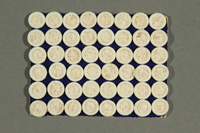
Card with 48 Dorset-style buttons owned by a Jewish Austrian refugee
Object
Unused set of handwoven buttons brought to the United States by Herta Schwarzbart Stoer when she emigrated from Vienna, Austria, in February 1939. The buttons were likely from one of Herta’s family member’s clothing businesses: either lingerie made by her parents, Arthur and Pauline, or children’s clothing made by her sister, Hilda. Herta lived in Vienna with her parents, and four siblings: Hilda, Fritz, Ella, and Hansi. In August 1914, Arthur was selected to fight in World War I, and three months later, he died of tetanus. As a result, Pauline closed the business, Hilda began making children’s clothing, and Fritz, Ella, Herta, and Hansi were sent to an orphanage. Herta was transferred to a boarding school for Jewish orphan girls, where she later returned as a teacher. In 1932, Hansi married and moved to Palestine. In early 1936, Herta began dating Leopold (Leo) Stoer. In June 1937, Pauline passed away. On March 13, 1938, Austria was annexed into Germany. Later that month, Herta and Leo married, but continued to live separately in Vienna. Leo immigrated to the US in September 1938, followed by Herta in February 1939. In September, the couple moved to California, where they began running a chicken farm to raise money to help their families immigrate. As World War II progressed, Herta and Leo lost contact with most family members. Herta later learned that her family members had been deported to concentration camps and killed in 1942 or 1943. Only her sister-in-law, Sidi, and nephew, Paul Schwarzbart, survived in hiding. Leo’s entire family had been deported to concentration camps and killn 1942.
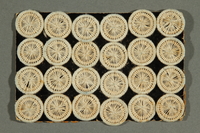
Card with 24 Dorset-style buttons owned by a Jewish Austrian refugee
Object
Unused set of handwoven buttons brought to the United States by Herta Schwarzbart Stoer when she emigrated from Vienna, Austria, in February 1939. The buttons were likely from one of Herta’s family member’s clothing businesses: either lingerie made by her parents, Arthur and Pauline, or children’s clothing made by her sister, Hilda. Herta lived in Vienna with her parents, and four siblings: Hilda, Fritz, Ella, and Hansi. In August 1914, Arthur was selected to fight in World War I, and three months later, he died of tetanus. As a result, Pauline closed the business, Hilda began making children’s clothing, and Fritz, Ella, Herta, and Hansi were sent to an orphanage. Herta was transferred to a boarding school for Jewish orphan girls, where she later returned as a teacher. In 1932, Hansi married and moved to Palestine. In early 1936, Herta began dating Leopold (Leo) Stoer. In June 1937, Pauline passed away. On March 13, 1938, Austria was annexed into Germany. Later that month, Herta and Leo married, but continued to live separately in Vienna. Leo immigrated to the US in September 1938, followed by Herta in February 1939. In September, the couple moved to California, where they began running a chicken farm to raise money to help their families immigrate. As World War II progressed, Herta and Leo lost contact with most family members. Herta later learned that her family members had been deported to concentration camps and killed in 1942 or 1943. Only her sister-in-law, Sidi, and nephew, Paul Schwarzbart, survived in hiding. Leo’s entire family had been deported to concentration camps and killed in 1942.
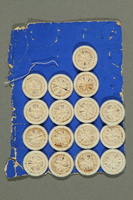
Partial card with 16 Dorset-style buttons owned by a Jewish Austrian refugee
Object
Partial set of handwoven buttons brought to the United States by Herta Schwarzbart Stoer when she emigrated from Vienna, Austria, in February 1939. The buttons were likely from one of Herta’s family member’s clothing businesses: either lingerie made by her parents, Arthur and Pauline, or children’s clothing made by her sister, Hilda. Herta lived in Vienna with her parents, and four siblings: Hilda, Fritz, Ella, and Hansi. In August 1914, Arthur was selected to fight in World War I, and three months later, he died of tetanus. As a result, Pauline closed the business, Hilda began making children’s clothing, and Fritz, Ella, Herta, and Hansi were sent to an orphanage. Herta was transferred to a boarding school for Jewish orphan girls, where she later returned as a teacher. In 1932, Hansi married and moved to Palestine. In early 1936, Herta began dating Leopold (Leo) Stoer. In June 1937, Pauline passed away. On March 13, 1938, Austria was annexed into Germany. Later that month, Herta and Leo married, but continued to live separately in Vienna. Leo immigrated to the US in September 1938, followed by Herta in February 1939. In September, the couple moved to California, where they began running a chicken farm to raise money to help their families immigrate. As World War II progressed, Herta and Leo lost contact with most family members. Herta later learned that her family members had been deported to concentration camps and killed in 1942 or 1943. Only her sister-in-law, Sidi, and nephew, Paul Schwarzbart, survived in hiding. Leo’s entire family had been deported to concentration camps and killed in 1942.
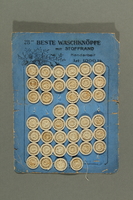
Card with 46 Dorset-style buttons owned by a Jewish Austrian refugee
Object
Partial set of handwoven buttons brought to the United States by Herta Schwarzbart Stoer when she emigrated from Vienna, Austria, in February 1939. The buttons were likely from one of Herta’s family member’s clothing businesses: either lingerie made by her parents, Arthur and Pauline, or children’s clothing made by her sister, Hilda. Herta lived in Vienna with her parents, and four siblings: Hilda, Fritz, Ella, and Hansi. In August 1914, Arthur was selected to fight in World War I, and three months later, he died of tetanus. As a result, Pauline closed the business, Hilda began making children’s clothing, and Fritz, Ella, Herta, and Hansi were sent to an orphanage. Herta was transferred to a boarding school for Jewish orphan girls, where she later returned as a teacher. In 1932, Hansi married and moved to Palestine. In early 1936, Herta began dating Leopold (Leo) Stoer. In June 1937, Pauline passed away. On March 13, 1938, Austria was annexed into Germany. Later that month, Herta and Leo married, but continued to live separately in Vienna. Leo immigrated to the US in September 1938, followed by Herta in February 1939. In September, the couple moved to California, where they began running a chicken farm to raise money to help their families immigrate. As World War II progressed, Herta and Leo lost contact with most family members. Herta later learned that her family members had been deported to concentration camps and killed in 1942 or 1943. Only her sister-in-law, Sidi, and nephew, Paul Schwarzbart, survived in hiding. Leo’s entire family had been deported to concentration camps and killed in 1942.
Leopold Stoer collection
Document
Contains a composition book bearing the name Hertha Schwarzbart and the dates 1921-22 handwritten on the cover.
Cream-colored underskirt with a diamond pattern owned by a Jewish Austrian refugee
Object
Diamond-patterned petticoat brought to the United States by Herta Schwarzbart Stoer when she emigrated from Vienna, Austria, in February 1939. The underskirt was created in the early 1900s by her parents, Arthur and Pauline, who ran their own lingerie manufacturing business. Herta lived in Vienna with her parents, and four siblings: Hilda, Fritz, Ella, and Hansi. In August 1914, Arthur was selected to fight in World War I, and three months later, he died of tetanus. As a result, Pauline closed the business, and sent Fritz, Ella, Herta, and Hansi to an orphanage. Hilda and Pauline ran a small children’s clothing business. Herta was transferred to a boarding school for Jewish orphan girls, where she later returned as a teacher. In 1932, Hansi married and moved to Palestine. In early 1936, Herta began dating Leopold (Leo) Stoer. In June 1937, Pauline passed away. On March 13, 1938, Austria was annexed into Germany. Later that month, Herta and Leo married, but continued to live separately in Vienna. Leo immigrated to the US in September 1938, followed by Herta in February 1939. In September, the couple moved to California, where they began running a chicken farm to raise money to help their families immigrate. As World War II progressed, Herta and Leo lost contact with most family members. Herta later learned that her family members had been deported to concentration camps and killed in 1942 or 1943. Only her sister-in-law, Sidi, and nephew, Paul Schwarzbart, survived in hiding. Leo’s entire family had been deported to concentration camps and killed in 1942.
Initialed, cream-colored underskirt with a diamond pattern owned by a Jewish Austrian refugee
Object
Monogrammed petticoat brought to the United States by Herta Schwarzbart Stoer when she emigrated from Vienna, Austria, in February 1939. The underskirt was likely part of her mother Pauline’s (née Flesch) trousseau, created prior to her marriage to Arthur Schwarzbart in 1900. Herta lived in Vienna with her parents, who ran their own lingerie manufacturing business, and four siblings: Hilda, Fritz, Ella, and Hansi. In August 1914, Arthur was selected to fight in World War I, and three months later, he died of tetanus. As a result, Pauline closed the business, and sent Fritz, Ella, Herta, and Hansi to an orphanage. Hilda and Pauline ran a small children’s clothing business. Herta was transferred to a boarding school for Jewish orphan girls, where she later returned as a teacher. In 1932, Hansi married and moved to Palestine. In early 1936, Herta began dating Leopold (Leo) Stoer. In June 1937, Pauline passed away. On March 13, 1938, Austria was annexed into Germany. Later that month, Herta and Leo married, but continued to live separately in Vienna. Leo immigrated to the US in September 1938, followed by Herta in February 1939. In September, the couple moved to California, where they began running a chicken farm to raise money to help their families immigrate. As World War II progressed, Herta and Leo lost contact with most family members. Herta later learned that her family members had been deported to concentration camps and killed in 1942 or 1943. Only her sister-in-law, Sidi, and nephew, Paul Schwarzbart, survived in hiding. Leo’s entire family had been deported to concentration camps and killed in 1942.
Short, white eyelet lace jacket owned by a Jewish Austrian refugee
Object
Short, eyelet-lace jacket brought to the United States by Herta Schwarzbart Stoer when she emigrated from Vienna, Austria, in February 1939. Herta lived in Vienna with her parents, Arthur and Pauline Schwarzbart, and four siblings: Hilda, Fritz, Ella, and Hansi. In August 1914, Arthur was selected to fight in World War I, and three months later, he died of tetanus. As a result, Pauline had to close the lingerie business they ran together before the war. Her daughter, Hilda began making and selling children’s clothing. Pauline’s younger children, Fritz, Ella, Herta, and Hansi, were sent to an orphanage. Herta was transferred to a boarding school for Jewish orphan girls, where she later returned as a teacher. In 1932, Hansi married and moved to Palestine. In early 1936, Herta began dating Leopold (Leo) Stoer. In June 1937, Pauline passed away. On March 13, 1938, Austria was annexed into Germany. Later that month, Herta and Leo married, but continued to live separately in Vienna. Leo immigrated to the US in September 1938, followed by Herta in February 1939. In September, the couple moved to California, where they began running a chicken farm to raise money to help their families immigrate. As World War II progressed, Herta and Leo lost contact with most family members. Herta later learned that her family members had been deported to concentration camps and killed in 1942 or 1943. Only her sister-in-law, Sidi, and nephew Paul Schwarzbart, survived in hiding. Leo’s entire family had been deported to concentration camps and killed in 1942.
Cream-colored textile with crocheted lace accents owned by a Jewish Austrian refugee
Object
Long textile with crocheted accents brought to the United States by Herta Schwarzbart Stoer when she emigrated from Vienna, Austria, in February 1939. Herta lived in Vienna with her parents, Arthur and Pauline Schwarzbart, and four siblings: Hilda, Fritz, Ella, and Hansi. In August 1914, Arthur was selected to fight in World War I, and three months later, he died of tetanus. As a result, Pauline had to close the lingerie business they ran together before the war. Her daughter, Hilda began making and selling children’s clothing. Pauline’s younger children, Fritz, Ella, Herta, and Hansi, were sent to an orphanage. Herta was transferred to a boarding school for Jewish orphan girls, where she later returned as a teacher. In 1932, Hansi married and moved to Palestine. In early 1936, Herta began dating Leopold (Leo) Stoer. In June 1937, Pauline passed away. On March 13, 1938, Austria was annexed into Germany. Later that month, Herta and Leo married, but continued to live separately in Vienna. Leo immigrated to the US in September 1938, followed by Herta in February 1939. In September, the couple moved to California, where they began running a chicken farm to raise money to help their families immigrate. As World War II progressed, Herta and Leo lost contact with most family members. Herta later learned that her family members had been deported to concentration camps and killed in 1942 or 1943. Only her sister-in-law, Sidi, and nephew, Paul Schwarzbart, survived in hiding. Leo’s entire family had been deported to concentration camps and killed in 1942.
Set of 10 Rorschach plates with folded cardboard enclosure owned by a Jewish Austrian refugee
Object
Rorschach ink blot test cards like those used by Dr. Leopold (Leo) Stoer to test patients in the United States following his emigration from Vienna, Austria, in September 1938. While studying for his dissertation in psychology, Leo learned how to use the cards to diagnose patients, which was still a new practice in the US. Leo lived in Vienna with his parents, Alfred and Karoline, and seven younger siblings: Juli, Grete, Hedi, Fritz, Erna, Trude, and Otto. In 1915, Alfred, a master decorator by trade, was selected to fight in World War I (1914-1918). Leo’s sister Hedi, died from whooping cough. After Leo graduated from school, he worked at an insurance company and took some university courses. He passed the university entrance exams in 1928, and began his PhD program the following year. In early 1936, Leo began dating Herta Schwarzbart. In November 1937, Leo was promoted after passing qualifying exams. On March 13, 1938, Austria was annexed into Germany. Later that month, Leo and Herta married, but continued to live separately in Vienna. Leo immigrated to the US in September 1938, after helping his family flee to Belgium. Herta followed him in February 1939. In September, the couple moved to California, where they began running a chicken farm to raise money to help their families immigrate. As World War II progressed, Herta and Leo lost contact with most family members. Leo later learned that his entire family had been deported to concentration camps and killed in 1942. All but two of Herta’s family members had been deported to concentration camps and killed by 1943.



